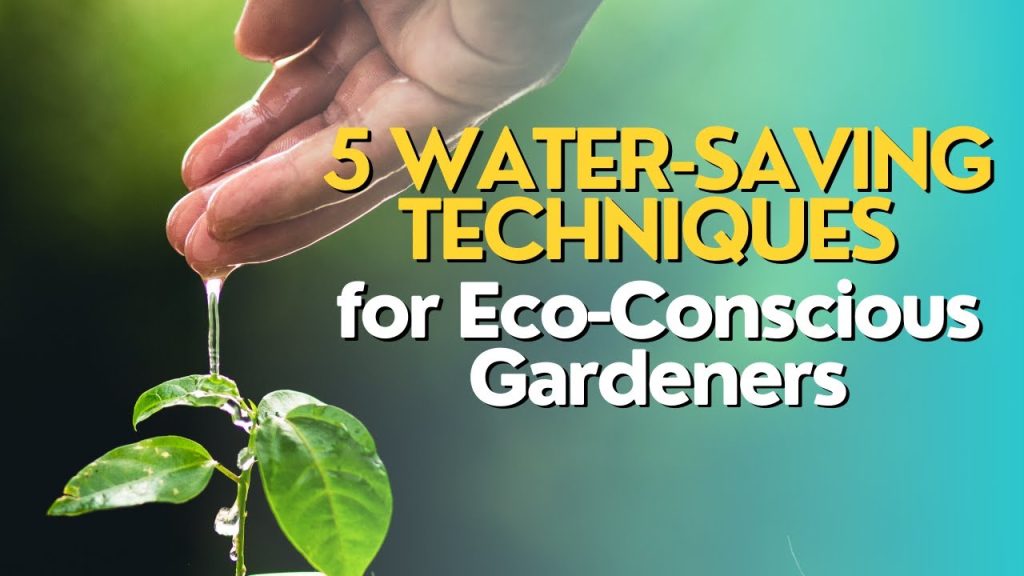As an eco-conscious gardener, conserving water is always at the forefront of my mind. Not only do I want to do my part in reducing water waste, but I also want to ensure that my plants and garden thrive without putting a strain on our precious water supply. Over the years, I’ve discovered a variety of water-saving techniques that have made a significant difference in my garden. Today, I want to share some of those tips with you, in hopes of inspiring you to become a more water-conscious gardener as well.
1. Choose drought-tolerant plants: One of the most effective ways to save water in your garden is by selecting plants that can withstand dry conditions. By opting for drought-tolerant species, you’ll significantly reduce the amount of water needed to keep them thriving. Native plants are often well adapted to your area’s climate and require minimal watering once established.
2. Mulch, mulch, mulch: Mulching is an absolute game-changer when it comes to water conservation. Adding a thick layer of organic mulch around your plants helps to retain moisture in the soil, reducing evaporation and keeping the roots cool. Additionally, mulch prevents weed growth, ensuring that water isn’t wasted on unwanted plants.
3. Efficient watering techniques: When it comes to watering your garden, it’s crucial to be mindful of how much water you use and when you use it. Watering early in the morning or late in the evening allows for better absorption, as it minimizes evaporation caused by the midday sun. Additionally, using a soaker hose or drip irrigation system ensures that water goes directly to the roots rather than being wasted on leaves or evaporating into the air.
4. Collect rainwater: One of the best water-saving investments you can make is installing a rainwater harvesting system. Rain barrels or even large storage tanks can collect rainwater from rooftops, which can then be used to irrigate your garden during dry spells. Not only does this help reduce your dependence on municipal water, but rainwater is also free of chemicals found in tap water, making it better for your plants.
5. Group plants with similar water needs: When planning your garden layout, consider grouping plants with similar water requirements together. This allows you to create separate irrigation zones based on plant needs, ensuring that water is distributed efficiently and not wasted on plants that don’t need as much hydration. An added bonus of this technique is that you’ll be able to identify and address any water issues more effectively.
6. Use efficient tools and equipment: Invest in water-efficient tools and equipment to make the most of every drop. For instance, adjustable nozzles or sprinklers with low precipitation rates can provide targeted watering without excessive runoff. Additionally, a trigger nozzle on your garden hose will allow you to control the flow of water, turning it off when not in use.
7. Regularly monitor soil moisture: Monitoring your soil’s moisture levels regularly is crucial in preventing overwatering. Invest in a soil moisture meter or simply perform the finger test by sticking your finger an inch into the soil. If it feels moist, hold off on watering. By avoiding unnecessary watering, you save both water and prevent root rot, giving your plants a better chance of thriving.
8. Practicing xeriscaping techniques: Xeriscaping is a landscaping method that aims to conserve water by using plants and materials adapted to dry climates. By incorporating features such as native plants, rocks, and gravel, you can create a beautiful, low-maintenance garden that requires minimal watering.
9. Regular maintenance and plant care: Proper garden maintenance can greatly contribute to water conservation. Removing weeds regularly ensures that water isn’t wasted on unwanted plants competing for resources. Deadheading spent flowers also encourages plants to focus their energy on new growth rather than seeds, reducing water needs. Additionally, inspecting for pests and diseases and promptly treating them prevents unnecessary water loss due to plant stress.
10. Educate yourself and others: Finally, becoming an eco-conscious gardener is a continuous learning experience. Stay informed about water-saving techniques, new technologies, and regional water restrictions. Share your knowledge with others, whether it’s fellow gardeners, friends, or neighbors. By inspiring others to conserve water in their gardens, you create a ripple effect that can make a significant impact on our environment.
Incorporating water-saving practices into your gardening routine not only benefits the planet but also enhances your gardening experience. By being mindful of our water consumption and implementing these tips, we can create beautiful, flourishing gardens while preserving our most valuable natural resource. So, let’s join hands, one gardener at a time, and make a positive difference in this world we call home.

